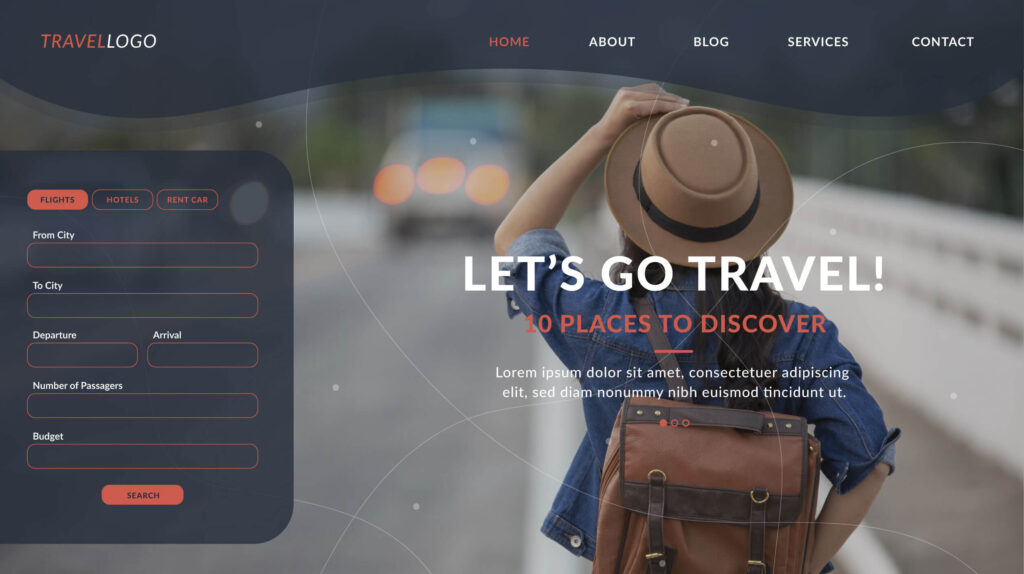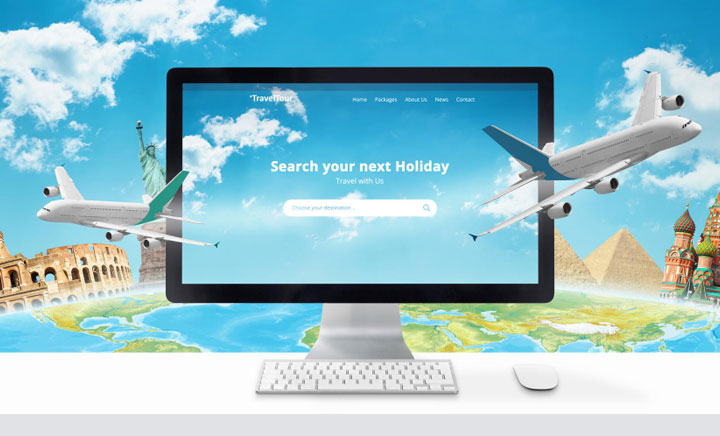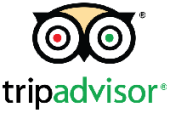A well-designed website is essential for driving bookings, enhancing customer experience, and establishing a strong, lasting presence in a crowded marketplace. This page dives into the critical role web design plays in boosting your brand, capturing the attention of potential travelers, and converting them into loyal customers. Whether you’re a hotel, travel agency, or tour operator, an effective website allows you to showcase your offerings, build trust, and differentiate your business from competitors.
Your website often serves as the first interaction customers have with your brand. It’s where they’ll form their first impressions, and a seamless, visually appealing design is key to encouraging further exploration. An engaging website not only entices users but also guides them through a simple, intuitive journey that ultimately leads to conversions—whether that’s booking a stay, signing up for a tour, or contacting you for more information.

The design of your website directly influences your ability to achieve key business goals. It’s more than just creating something aesthetically pleasing; it’s about ensuring that every design decision contributes to enhancing user experience, building brand credibility, and driving long-term growth. Here are the primary reasons why web design is crucial to your business success:
Having an attractive website is one thing, but ensuring it’s discoverable is just as important. SEO plays a key role in driving organic traffic to your site. A website designed with SEO best practices in mind—such as fast load times, strategic keyword placement, optimized images, and a clear site structure—makes it easier for potential customers to find your services when searching online. Improved SEO leads to higher rankings in search engine results pages (SERPs), which means more visibility, more traffic, and more opportunities to convert visitors into customers.
A thoughtfully designed website is not just a visual asset; it is a powerful tool that helps strengthen your online presence, drive sales, and foster long-term relationships with your customers. Every element, from layout to functionality, should serve the ultimate purpose of improving business performance and delivering a memorable user experience.
The surge in mobile device usage has transformed how people interact with websites, particularly in the travel and tourism industry. A responsive web design ensures content, images, and functionalities adapt seamlessly across devices, offering users a consistent experience regardless of screen size. For travel websites, this means providing quick access to booking tools, maps, and itinerary planners through touch-friendly interfaces.
Additional features include:
A slow-loading website risks losing visitors before they even explore its offerings. Speed optimization is not just a performance metric—it’s a user experience necessity. Travelers often browse during commutes or breaks, and delays can frustrate potential customers.
Key strategies include:
The booking system is the heart of any travel website, facilitating smooth conversions from interest to action. A well-integrated system offers:
Advanced booking systems might also include dynamic pricing tools, upselling features (e.g., adding travel insurance), and multi-destination options for complex itineraries.
The saying “a picture is worth a thousand words” resonates deeply in travel web design. Stunning visuals don’t just attract—they evoke emotions and inspire actions.
In addition to aesthetics, visuals should be optimized for performance and accessibility. Include descriptive alt texts and captions for better engagement and SEO impact.
A travel website’s success hinges on its visibility in search engines. SEO strategies for travel web design extend beyond standard practices to include:
Web design for travel and tourism extends beyond aesthetics, focusing on functionality, accessibility, and engagement. By emphasizing a user-friendly approach combined with technical excellence, travel websites can inspire visitors, simplify planning, and turn casual browsers into lifelong explorers.
Each travel and tourism business has distinct requirements, and a one-size-fits-all approach to web design often falls short. Align your website’s features with your specific business model, to create a tailored experience that resonates with your audience.
Whether you’re a hotel, tour operator, or travel influencer, a customized website not only enhances user satisfaction but also boosts conversions. Effective design ensures seamless navigation, highlights key offerings, and meets customer expectations. From intuitive booking systems to immersive visuals and targeted content, a well-designed website becomes a powerful tool for engaging users, building trust, and driving meaningful results.
An essential feature for hospitality businesses is a smooth, user-friendly booking system. Integrating live availability ensures guests can see the real-time status of rooms or properties, making the booking process transparent and hassle-free. A well-designed booking system should also include filtering options, secure payment methods, and flexible cancellation policies to enhance convenience and reduce booking friction.
Visual content plays a pivotal role in converting website visitors into guests. High-quality images and 360-degree virtual tours provide an immersive experience that allows potential customers to explore rooms, amenities, and common areas from anywhere. This feature helps build trust and gives guests a better understanding of what to expect during their stay, increasing the likelihood of bookings.
Showcasing reviews from previous guests is crucial for building trust and social proof. A transparent review system, where guests can rate rooms, services, and experiences, adds authenticity to the website. Incorporating user-generated content, such as photos or videos from happy guests, further enhances credibility. Having a section for property responses to reviews also fosters trust and shows that the business values feedback.
Offering helpful local guides on attractions, dining, and activities enriches the guest experience. Detailed suggestions on how to navigate the area, along with insider tips, can elevate a guest’s stay. Including transportation options and seasonal recommendations ensures guests are well-prepared, enhancing both their satisfaction and the chances of repeat bookings.
Help guide potential guests, answering questions about packing, local customs, and best travel tips.
Ensure visitors know exactly what to do, increasing their overall experience and extending their stay.
An essential feature is the ability for customers to create personal accounts where they can save their trips, preferences, and past bookings. This simplifies repeat bookings and allows customers to easily access their itineraries, manage personal details, and receive tailored recommendations for future trips. Additionally, account features could include loyalty program tracking, special offers, and customized itineraries.
Travel agencies should incorporate intelligent trip suggestion tools powered by user preferences, past behavior, and popular trends. These tools can automatically recommend destinations, packages, and activities based on a customer’s profile. Personalization enhances the user experience by presenting relevant options, which can increase conversion rates and customer engagement. It also builds trust by demonstrating that the agency understands the user’s travel style.
Each destination should have its own dedicated page featuring detailed information about the area, suggested itineraries, activities, and booking options. This allows potential travelers to get a comprehensive overview of what they can expect, and it helps search engine optimization (SEO) by targeting specific keywords related to the destination.
Engaging blog posts featuring travel trends, upcoming hot spots, and must-see locations can inspire customers and give them ideas for their next adventure. These blogs also help position the agency as an expert in the travel industry, offering valuable insights and recommendations to potential clients.
Many travelers seeking adventure tours may have specific questions related to safety, difficulty levels, or equipment requirements. An FAQ section dedicated to addressing these concerns provides valuable information and helps reduce potential customers’ hesitation. It can also improve customer satisfaction by anticipating their needs before they book.
Sharing stories of past successful tours, particularly those that highlight unique or extraordinary experiences, helps build credibility and excitement. These stories can include customer testimonials, photos, and highlights from the tours themselves. Case studies also demonstrate the tour operator’s ability to organize memorable and well-received experiences, which can be a key selling point for new customers.
Tour operators should provide clear and detailed itineraries for each tour package, highlighting key activities, locations, and timelines. Rich visuals, such as photos and videos from previous tours, give potential customers a sense of the experience they can expect. This not only helps to generate excitement but also provides reassurance that the tour is well-organized and offers value for money.
Creating content that gives visitors an exclusive behind-the-scenes look into how experiences are curated or executed can build excitement and intrigue. Videos or blog posts showcasing the preparation, guides, or local culture involved in delivering the experiences add a personal touch and help customers feel more connected to the business.
Showcasing user-generated content, such as photos or videos shared by past participants, allows potential customers to see real experiences through the eyes of others. This type of content acts as social proof, encouraging new customers to trust the business and visualize themselves enjoying the activities. Galleries could include testimonials, adventure snapshots, or highlights from previous experiences.
Providing potential guests with the option to request personalized consultations or bespoke packages is crucial for luxury and wellness travel businesses. The website should feature easy-to-fill forms where customers can submit their preferences and inquiries regarding tailored experiences, exclusive accommodations, or wellness programs. This personalized touch enhances the customer experience and demonstrates a high level of attention to detail.
Blog posts that highlight luxurious accommodations, premium services, and exclusive experiences appeal to high-net-worth individuals. These posts can showcase trending destinations, luxurious amenities, and special promotions, helping the business stand out in the luxury travel market.
Transportation providers, especially for car rentals and shuttle services, should integrate route planning tools that allow customers to easily map out their journeys. These tools should help users plan the best routes, estimate travel times, and find points of interest along the way. For cruise lines, itinerary details, such as ports of call, excursion options, and on-board activities, should be clearly outlined to assist customers in planning their travel experience.
Real-time pricing and availability integration is crucial for providing an up-to-date experience for customers. For car rentals and shuttle services, this means showing available vehicles or shuttle slots based on customer input (e.g., pick-up and drop-off times). For cruise lines, it means displaying availability for specific cabins or excursions. Having transparent pricing and availability ensures that customers are not frustrated by hidden fees or unavailable options during the booking process.
Transportation providers should leverage partnerships with hotels, tour operators, or local attractions to offer cross-promotions. For example, car rental companies could offer discounted rates for customers staying at partner hotels, or cruise lines could promote excursions in collaboration with local tour guides. By showcasing these partnerships, transportation providers can enhance the value of their services and create a more seamless travel experience for customers.
Interactive route maps or detailed planners enhance the customer journey, offering features like visualizing car rental routes with nearby gas stations or cruise ship layouts with port info, ensuring a seamless travel experience.
Blog posts like “How to Make the Most of Your Car Rental” or “Cruise Travel Tips” provide practical advice on saving time and money, adding value and improving SEO while encouraging customers to visit the site beyond booking.
For travel tech startups that have mobile applications, integrating app download prompts directly on the website encourages users to download the app and stay engaged. Offering the app for both iOS and Android platforms ensures maximum reach. Additionally, having app-exclusive features or benefits—such as mobile-only booking discounts, offline access, or personalized notifications—can increase user retention and make the app an essential tool for travelers.
Dynamic, real-time content is critical for any travel tech platform, especially for services like flight booking, hotel reservations, and transportation options. By integrating live data, such as flight prices, availability, or real-time updates on trips and services, customers can make quick and informed decisions. This real-time information can also include notifications for price drops, flight status updates, or changes in availability, providing added value to users and keeping them engaged with the platform.
Clear guides or tutorials, including step-by-step instructions, video demos, or interactive tutorials, help users confidently navigate the platform. This boosts engagement, especially for first-time users, and builds trust in the platform’s usability.
Event-based travel businesses, especially those organizing destination weddings or MICE (Meetings, Incentives, Conferences, and Events), should showcase high-quality photo galleries of past events. These galleries act as visual proof of the business’s ability to host successful and memorable events. Photos should highlight various aspects of the event, such as the venue setup, guest experiences, and special moments, to provide potential clients with an idea of what they can expect. Including a variety of styles and themes (e.g., beach weddings, elegant ballroom setups, or corporate conferences) helps attract a broader range of clients.
Event planning can be complex, so offering inquiry forms that allow customers to provide detailed information about their event is essential. These forms should capture specifics such as the type of event (e.g., wedding, conference, retreat), group size, preferred dates, venue choices, and any special requests. A customized form ensures that clients can easily convey their needs, and it also allows the event organizer to prepare tailored quotes or suggestions based on the client’s requirements.
Offering valuable resources related to event planning can help position the business as a trusted expert in the field. A dedicated section on the website could feature tips on everything from choosing the right venue to coordinating with vendors, managing guest lists, or creating the perfect itinerary. Providing downloadable checklists, budget planners, or timelines for various types of events can ease the planning process for customers and ensure they feel supported at every stage.
Publishing blog posts on popular wedding destinations helps attract clients by showcasing unique locations, ideal visiting times, and special features like local traditions or landmarks. Similarly, posts on corporate event destinations or MICE venues appeal to business clients seeking the perfect place for meetings or conferences.
Corporate event planners benefit from detailed guides on selecting venues, arranging team-building activities, and creating event agendas. Offering sample itineraries and tips for attendee engagement adds value and positions the business as a trusted resource for corporate clients.
A visually appealing, stylish blog design is crucial for travel content creators to engage their audience. A clean, modern layout with intuitive navigation allows users to easily browse through posts, categories, and pages. Content creators should prioritize a design that highlights their brand, incorporates captivating images from their travels, and provides an enjoyable user experience. The design should be responsive, ensuring that visitors can easily access content across all devices, especially mobile phones.
Many travel bloggers and influencers monetize their content through affiliate marketing and e-commerce platforms. Integrating affiliate links within relevant blog posts, reviews, or destination guides is essential for generating revenue. This includes offering travel gear, hotel booking platforms, flight comparison tools, or tour packages that are aligned with the content. Additionally, integrating an online store where the creator can sell branded merchandise, travel guides, or e-books can enhance earnings and diversify income streams.
Since travel influencers rely heavily on social media platforms like Instagram, YouTube, and TikTok, embedding their social media feeds directly into their websites adds value to the user experience. This keeps the content fresh and continuously updated, encouraging visitors to follow the influencer on various platforms. Social media feeds also allow the audience to interact with the creator’s latest posts, videos, and stories, increasing engagement and promoting cross-platform growth.
Content creators can create resource pages featuring trusted travel gear, gadgets, apps, and services. These pages can focus on categories like “Essential Travel Gear for Solo Travelers” or “Best Luggage for Long-Term Travel.” Including affiliate links or brand partnerships can generate extra income while providing valuable recommendations to readers.
By publishing in-depth content on specialized travel topics, such as solo travel, budget backpacking, luxury escapes, or adventure tourism, content creators can establish authority in the travel space. Posts like “How to Travel Like a Pro” or “Hidden Gems in [Destination]” offer valuable insider tips, encouraging readers to return for more insights.
The website should include clear, prominent call-to-action (CTA) buttons that direct users toward booking tickets, scheduling tours, or making inquiries. Whether it’s reserving a spot for a guided tour, buying tickets to a local attraction, or inquiring about services, these CTAs should be easy to spot and encourage immediate action. This reduces friction in the customer journey and increases conversion rates.
Blog posts or landing pages like “Top Things to Do in [Location]” attract tourists by featuring must-see attractions, hidden gems, local festivals, and restaurants. Curating a list of activities positions local services as experts and boosts SEO, driving organic traffic.
Interactive maps showing points of interest, transport options, and amenities help visitors navigate easily. Downloadable guides, like walking tours or event calendars, allow tourists to plan offline, providing detailed information on attractions and suggested itineraries.

We bring years of experience working exclusively with travel and tourism businesses, giving us deep insight into your industry’s unique needs. Our team understands the challenges you face, and we create tailored strategies designed to achieve measurable success. We leverage our expertise to help you navigate the competitive digital landscape and reach your target audience effectively.
We understand how important it is for your travel business to stand out in a crowded digital landscape. Your website is the cornerstone of your online presence, and we’re here to ensure it not only looks amazing but also drives measurable growth. Whether you’re looking to enhance user experience, streamline booking systems, or create engaging content, our team is dedicated to delivering a solution tailored to your unique needs and goals.
Ready to Take Your Website to the Next Level? Don’t wait—let’s get started on creating a website that perfectly aligns with your business and attracts the right audience. We offer a free consultation where we’ll dive deep into your business objectives, target audience, and brand identity. During this consultation, we’ll also provide a custom design mockup to give you a preview of how your new site will look and feel.
By working with us, you can expect a website that not only captures your brand’s essence but also drives real, measurable results in terms of customer engagement, conversions, and brand loyalty.
Let’s work together to create a travel website that not only attracts visitors but also converts them into loyal customers. We’re excited to help you grow your travel business and look forward to the opportunity to collaborate with you!
With over 16 years of demonstrated success, we are a trusted partner to leading industry authorities and top platforms in digital marketing and web design.
















Travel & Tours Digital Marketing is the industry standard for travel and tourism digital marketing. We build lasting relationships through results, not long-term contracts.